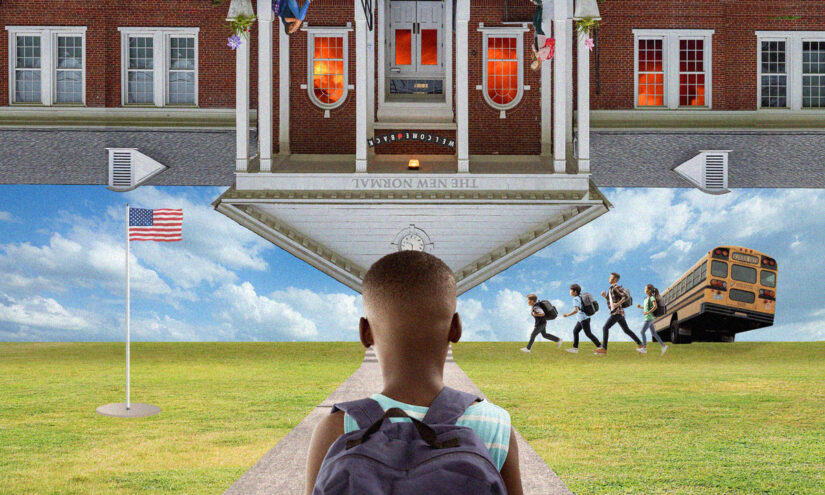COVID Brief: What Happens When the U.S. Ends the Public Health Emergency in 97 Days?
A biweekly roundup of headlines about how the pandemic is shaping schools and education policy, vetted by AEI Visiting Fellow John Bailey

Get stories like this delivered straight to your inbox. Sign up for The 74 Newsletter
We need your help: Please take this short survey to share what you think of this series.
This is our weekly briefing on the pandemic, vetted by John Bailey. See the full archive.
This Week’s Top Story
White House to End COVID Public Health Emergency May 11
The White House announced plans to end the public health emergency for COVID-19 on May 11.
- Statement of Administration Policy
- Kaiser Family Foundation has the best list of what the end of the emergency will mean for policies.
- Education angle: A Biden administration official told the AP “that ending the health emergencies will not change the legal argument for student loan debt cancellation, saying the COVID-19 pandemic affected millions of student borrowers who might have fallen behind on their loans during the emergency.”
- The COVID-19 emergency’s end will mean new costs and hassles. Politico has a good list of the implications.
- Many will have to pay for COVID-19 vaccines, tests and treatments. People without health insurance will have to pay out of pocket, while those with private plans could see more costs, depending on the terms of their coverage.
- Employers will no longer be able to offer telehealth access as a premium, tax-free benefit separate from other health plans.
- Other administrative rules that helped people receive their Supplemental Nutrition Assistance Program benefits will end.
- White House COVID-19 Response Coordinator Dr. Ashish Jha posted a helpful thread about what happens with the May 11 deadline.
The Big Three

Students Lost One-Third of a School Year to Pandemic
- New York Times on a new study: “Children experienced learning deficits during the COVID pandemic that amounted to about one-third of a school year’s worth of knowledge and skills, according to a new global analysis, and had not recovered from those losses more than two years later.”
- “Thomas Kane, the faculty director of the Center for Education Policy Research at Harvard, who has studied school interruptions in the United States, reviewed the global analysis. Without immediate and aggressive intervention, he said, ‘learning loss will be the longest-lasting and most inequitable legacy of the pandemic.’ ”
- “A separate review of test scores from 2.1 million students in the United States highlighted the impacts of economic disparity. Students at schools in communities with high poverty levels spent more of the 2020-2021 school year learning remotely than those at schools in wealthier communities did, and students in poorer schools experienced steeper declines in performance when they were remote.”
- The 74 shares 4 top takeaways
Engaging Chronically Absent Students
- A study shows that the Connecticut Learner Engagement and Attendance Program (LEAP) made a significant difference in reducing absenteeism, particularly with secondary school students.
- FutureEd: “The new research is important for two reasons. First, it showcases a powerful intervention for improving student attendance, which is essential for academic recovery. Second, it highlights a second Connecticut initiative: using federal aid to create a research consortium that can turn around results quickly and guide district-level work.”
- “Fifteen school districts received money for Connecticut’s LEAP program, which they used to pay school staff and community organizers to visit nearly 8,700 chronically absent students and families at their homes or other locations. One district targeted entire neighborhoods rather [than] concentrating on students with the most severe absenteeism problems and saw little change in attendance patterns.”

Schools’ New Normal: Teacher Shortages, Repeat Meals, Late Buses, Canceled Classes
- Via The 74: “This is the new normal in schools across the country: Classes are back in person but day-to-day operations are a far cry from pre-pandemic norms, the lingering effects of the COVID crisis challenging everything from staffing and student mental health to school lunches.”
- “By 5 a.m., a high schooler in a small city between Orlando and Tampa, Florida, is up — sleep deprived but with a sense of urgency: He has to reach the Wesley Chapel bus hub by 5:59 a.m, to get to class by 7:06 a.m. His school now starts earlier to make up for hurricane days and remote learning.”
- “At a Milwaukee Catholic high school, social studies teacher Mary Talsky has noticed lots of empty seats. For every email about a kid out sick, she gets three to four times more about absences because of mental health issues: My kid is struggling with anxiety and can’t come in today; I’m taking my child to an appointment with a psychiatrist.”
Federal Updates
Education Department: “$63 Million to Expand Community Schools and Increase Social, Emotional, Mental Health and Academic Support for Students, Educators and Families.” (Press Release)
- The White House also released a toolkit.
Education Department: Secretary Miguel Cardona highlighted the key focus areas of “Raise the Bar: Lead the World” in a speech (Press release / Remarks)
Institute of Education Sciences: Announces Award for AI-Augmented Learning for Individuals with Disabilities.
COVID-19 Research
FDA Advisers Recommend Replacing Original COVID Vaccine With Bivalent Omicron Shots for All Doses
- The Food and Drug Administration vaccine advisory group unanimously recommended streamlining COVID-19 vaccine campaigns by offering just the newer bivalent (two-strain) versions of the vaccine for both primary and booster series.
- CNBC: “The FDA has proposed moving to a system that resembles how the agency updates and rolls out flu shots every year. The agency would select a COVID vaccine formulation in June to target the variant that is expected to dominate in the fall and winter. That formulation would be used by all manufacturers for all doses.”
- More via CIDRAP and NPR
- Stat shared a liveblog of the meeting.
Annual COVID-19 Booster? FDA Cliffs Notes
- Via Katelyn Jetelina: “The [Centers for Disease Control and Prevention] presented data that is not surprising: Most hospitalizations and deaths occur among older adults. Interestingly, children under 6 months are being hospitalized at about the same rates as those aged 50-64 years. This highlights the importance of maternal vaccination during pregnancy.”
- “The bivalent vaccines are working well. Adults who received a bivalent booster had 3 times lower risk of hospitalization and 2 times lower risk of dying compared to those who were vaccinated but did not get the bivalent booster. Both were more effective than no vaccination.”
- “Moderna surprised us today with new data, though: a randomized trial in the U.K. They randomly gave people the original vaccine or the bivalent vaccine (BA.1 formula) as a booster. The bivalent vaccine did better. This really put the debate to rest.”
- “I was excited to see Novavax data. It’s clear this is a solid vaccine. And their presentation was much more useful than Moderna’s or Pfizer’s. To demonstrate, they included data on mixing Novavax with mRNA vaccines. It looks like no matter how you mix the two, the combinations work about the same way.”
New Study Finds Vaccines Are Safe and Effective for Kids
- ABC News on a new study: “Two doses of the mRNA COVID-19 vaccine among school-aged children safely and effectively reduces COVID-19 infection risk as well as associated risks for developing multisystem inflammatory syndrome and COVID-19 related hospitalizations.”
- “[Researchers] found vaccinated children had lower rates of infection and less severe symptoms if they did end up infected. Severe reactions to the shot were rare, and any local injection irritation went away after several days. The low rates of severe side effects should be reassuring for parents and guardians worried about adverse events following vaccination, according to the study’s authors.”
- “The study also found only a small increase in risk for kids to develop inflammation of the heart (myocarditis) after COVID-19 vaccination. It found that there are 1.8 cases of myocarditis per million children who get two doses of the vaccine, a comparable or slightly higher rate than in children diagnosed with myocarditis before the COVID-19 pandemic.”
City & State News
Arizona: A for Arizona announced additional awardees of the Arizona Transportation Modernization Grant Program, an initiative to modernize and improve access to reliable and safe transportation for students. The application for the final round of grants is open until March 29.
Illinois: Public school enrollment continues to drop
- “Preliminary data released last week by the Illinois State Board of Education shows overall enrollment dropped by about 31,000 students — or 1.7% — between last school year and the current one, according to numbers as of Dec. 14.”
- “Chicago Public Schools accounts for at least a quarter of the decline. The district lost 9,000 students and its place as the third-largest school district in the country.”
Indiana: Indianapolis district test scores have rebounded close to pre-pandemic levels, but remain far from 2025 goal.
Michigan: Gov. Gretchen Whitmer wants a tutoring program in place before spring break.
- “Students in Lansing and Saginaw lost the equivalent of a year’s worth of math and reading lessons, while students in Birmingham lost about a fifth of a school year, new data shows, according to a report from The Education Trust – Midwest.”
North Carolina: A report released by the Department of Public Instruction’s Office of Learning Recovery and Acceleration found that students scored better on the state’s End-of-Grade and End-of-Course exams during the 2020-21 school year if their teachers had in past years shown strong student outcomes.
In-Depth
A Teacher Shortage So Acute That Students Have to Learn Without One
- Via the Washington Post
- “In rural Mississippi, the geometry teacher is a recording. The chemistry students often teach themselves. Rural and Southern states face a crisis.”
- “Researchers trying to understand the teacher shortage could find sufficient data for only 37 states, and among those, Mississippi’s was the worst. For every 10,000 students there, 69 teacher positions are unfilled or filled by someone without traditional credentials. That’s 159 times the ratio in Missouri, according to their working paper, published by Brown University’s Annenberg Institute for School Reform.”
- Related: A Practical Toolkit for Leaders to Address Teacher Shortages, via Bellwether and Overdeck
Schools Speed Up COVID-Aid Spending after a Slow Start: Via the WSJ.
- “Districts have drawn on about a quarter of the $122 billion in federal money, up from 7% in May.”
- “Illinois has spent about 32% of its $4.8 billion in federal pandemic relief and is on track to meet the deadline for depleting the funds,” said Krish Mohip, deputy chief of operational education for the Illinois State Board of Education. “Salaries are the largest category for schools’ pandemic relief spending in the state, accounting for almost 37% of those expenditures, he said.”
- “New York City’s school system, the largest in the U.S., has used about [a third], spending more than $1.5 billion of the $4.8 billion it received, according to city education officials. New York City is allocating just over 30% of the money for academic recovery efforts such as literacy programs.”
How Parenting Today Is Different, and Harder
- The NYT on the recent Pew survey
- “Today’s parents spend more time and money on their children than previous generations — working mothers spend as much time with their children as stay-at-home mothers of the 1970s — and feel more pressure to be hands-on. Especially for college-educated mothers with careers, the demands have caught them off guard, economists have found.”
- “At the same time, many jobs have become all-consuming, paying people disproportionately more per hour for working long hours and being available anytime — but at a cost.”
At $611 a Day Per Student, Some Question if L.A. Schools’ Extra Learning Days Are Worth It
- Via the LA Times: Extra learning days “came at considerable expense — about $611 per day per student for up to two added ‘acceleration days.’ “
- “The bonus schooling on Dec. 19 and 20 cost $36 million. After a heavy promotional push, about 17% of the district’s 422,276 students signed up; however, less than 9%, or 36,486, showed up, according to newly released data.”
- “Other problems emerged. Some teachers complained they were unable to plan effectively because they did not have advance access to rosters and student data. Under the plan, students were divided by groups into those who needed to catch up and those who would receive enrichment.”
…And on a Lighter Note
The Detroit Youth Choir: Performs “Thunder”
“It’s a Lovely, Warm Feeling. I Belong.” Peter Davies is a 100-year-old who volunteers his time to teach elementary school children to read.
Thank you for reading to the end! Please take this short survey to share what you think of this series.
For even more COVID policy and education news, subscribe to John Bailey’s daily briefing via Substack.
Disclosure: John Bailey is an adviser to the Walton Family Foundation, which provides financial support to The 74.
Get stories like these delivered straight to your inbox. Sign up for The 74 Newsletter

;)
